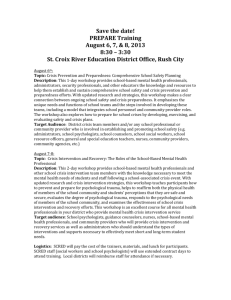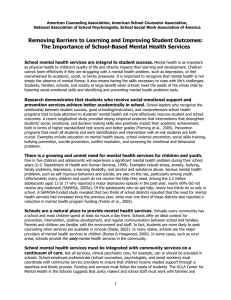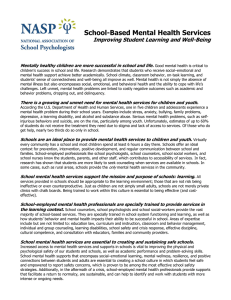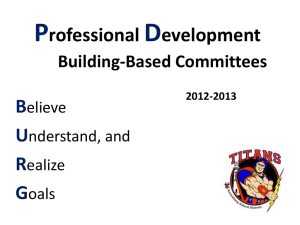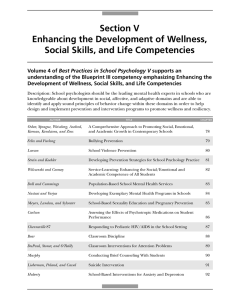Effective School Crisis Preparedness and Response: Policy Recommendations
advertisement
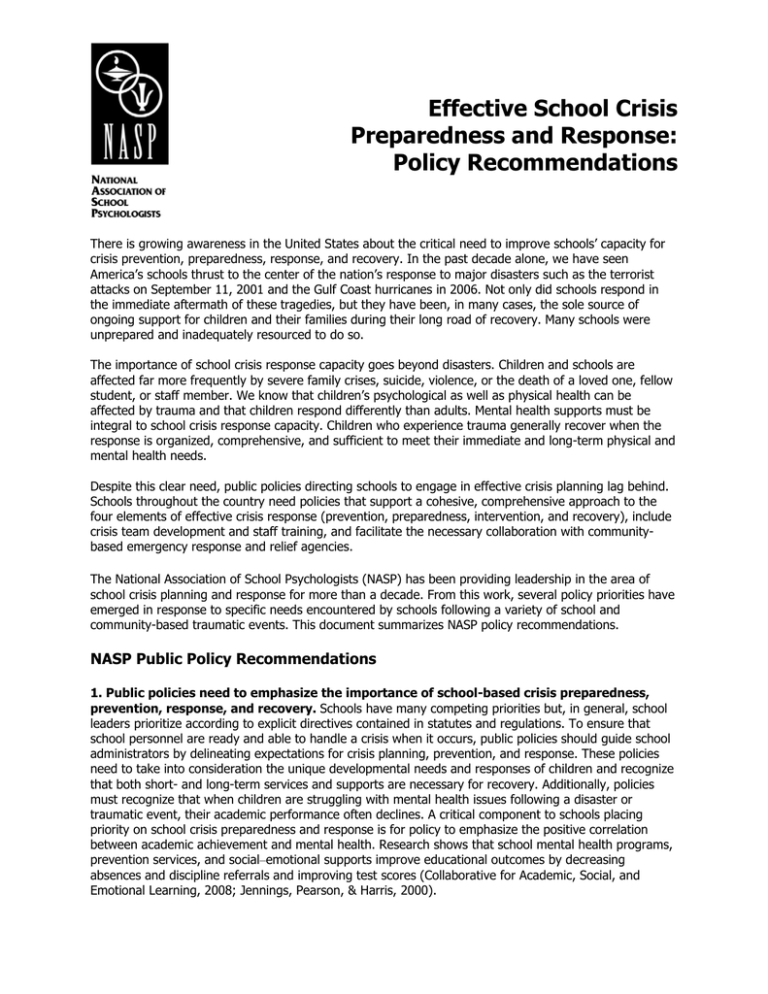
Effective School Crisis Preparedness and Response: Policy Recommendations There is growing awareness in the United States about the critical need to improve schools’ capacity for crisis prevention, preparedness, response, and recovery. In the past decade alone, we have seen America’s schools thrust to the center of the nation’s response to major disasters such as the terrorist attacks on September 11, 2001 and the Gulf Coast hurricanes in 2006. Not only did schools respond in the immediate aftermath of these tragedies, but they have been, in many cases, the sole source of ongoing support for children and their families during their long road of recovery. Many schools were unprepared and inadequately resourced to do so. The importance of school crisis response capacity goes beyond disasters. Children and schools are affected far more frequently by severe family crises, suicide, violence, or the death of a loved one, fellow student, or staff member. We know that children’s psychological as well as physical health can be affected by trauma and that children respond differently than adults. Mental health supports must be integral to school crisis response capacity. Children who experience trauma generally recover when the response is organized, comprehensive, and sufficient to meet their immediate and long-term physical and mental health needs. Despite this clear need, public policies directing schools to engage in effective crisis planning lag behind. Schools throughout the country need policies that support a cohesive, comprehensive approach to the four elements of effective crisis response (prevention, preparedness, intervention, and recovery), include crisis team development and staff training, and facilitate the necessary collaboration with communitybased emergency response and relief agencies. The National Association of School Psychologists (NASP) has been providing leadership in the area of school crisis planning and response for more than a decade. From this work, several policy priorities have emerged in response to specific needs encountered by schools following a variety of school and community-based traumatic events. This document summarizes NASP policy recommendations. NASP Public Policy Recommendations 1. Public policies need to emphasize the importance of school-based crisis preparedness, prevention, response, and recovery. Schools have many competing priorities but, in general, school leaders prioritize according to explicit directives contained in statutes and regulations. To ensure that school personnel are ready and able to handle a crisis when it occurs, public policies should guide school administrators by delineating expectations for crisis planning, prevention, and response. These policies need to take into consideration the unique developmental needs and responses of children and recognize that both short- and long-term services and supports are necessary for recovery. Additionally, policies must recognize that when children are struggling with mental health issues following a disaster or traumatic event, their academic performance often declines. A critical component to schools placing priority on school crisis preparedness and response is for policy to emphasize the positive correlation between academic achievement and mental health. Research shows that school mental health programs, prevention services, and social–emotional supports improve educational outcomes by decreasing absences and discipline referrals and improving test scores (Collaborative for Academic, Social, and Emotional Learning, 2008; Jennings, Pearson, & Harris, 2000). 2. Public policies need to provide schools with opportunities to help build the capacity of school-based teams to plan for and respond to crises. Schools’ capacity to develop crisis plans and prepare staff for crisis response is directly related to the funding and leadership opportunities presented by the state and federal government. Building the capacity of school-based teams is important for a variety of reasons. (a) School-based personnel have an ongoing relationship with, and knowledge of, students, their families, and the school community. This familiarity is essential when assessing the degrees to which individuals have been affected by a traumatic event. (b) School-employed mental health personnel remain in the school community throughout the recovery period and can monitor and respond to emerging and residual effects of the crisis on the system, faculty, and students. (c) School-employed mental health personnel understand the processes of teaching and learning and how these relate to crisis recovery. (d) School-employed personnel are trained in school systems and law. (e) School-employed personnel have existing relationships with families, thereby increasing the ease and comfort level for which parents or guardians are willing to access crisis intervention support. Leadership provided by state governmental agencies can help promote consistent professional development, planning, and schoolbased response models. Importantly, professional development and planning are ongoing activities, not one-time static endeavors. 3. Public policies need to encourage the development of a centralized repository of information, materials, and resources where proven practices in school crisis preparation, prevention, and response could be disseminated and easily accessed by the public. A national technical assistance center or similar entity whose charge it is to gather, evaluate, and disseminate school-based crisis resources, programs, activities, training, and supports related to all phases of school crisis response would provide significant assistance to state and local governments in preparing for and responding to a crisis. No such central source of information about best practices focused on school crisis response and youth currently exists. Without a centralized source of resource information, materials, and training, incomplete information, fragmentation of services and supports, and inconsistent practices persist. Additionally, a national technical assistance center should also review existing school-based crisis preparedness and response research and identify and promote new areas for research that are needed. 4. Public policies need to provide immediate access to emergency funding for schools for the purpose of comprehensive short- and long-term crisis response and recovery activities that include both physical and mental health supports. Current legislation provides “state and local governments” with access to emergency funding for the purpose of restoration of physical structures, replacement of materials and resources, and for individual emergency care such as medical, dental, or mental health supports. Displacement of children from their homes and their neighborhood schools can result in additional trauma as they struggle to cope without their normal sources of stability and support. Occasionally, schools report delays in receiving funding created by funding silos and bureaucratic structures that impede the swift delivery of funds. Policies should streamline how funds filter down to individual schools and students so that the recovery work can begin quickly. 5. Public policies need to explicitly direct community and school responders to work collaboratively for comprehensive crisis response services to children and their families. Schools are integral to an overall community crisis response on many levels (providing a safe haven, disseminating information, identifying individuals at risk, providing mental health services, supporting teachers and administrators, linking individuals with community services, tracking displaced families, supporting long-term recovery, serving as a source of normalcy and structure). However, much of the existing legislation emphasizes the role of community responders in crisis planning and intervention. Such legislation needs to be explicit about the role of schools in providing crisis response services, while jointly collaborating with local community agencies and organizations (public and private). Collaboration needs to establish clear communication and response protocols, expectations for information and resource sharing, and for the efficient use and dissemination of goods and services. Additionally, public policies need to predict potential areas of conflict that may arise based upon differences in organizational and system functioning (i.e., FERPA vs. HIPAA). For more information and additional hearing handouts, visit http://www.nasponline.org/advocacy © 2009 National Association of School Psychologists, 4340 East West Highway, Suite 402, Bethesda, MD 20814—(301) 657-0270.
